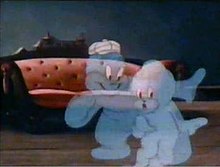
Looney Tunes is an American animated franchise produced and distributed by Warner Bros. It began as a series of short films that originally ran from 1930 to 1969, concurrently with its partner series Merrie Melodies, during the golden age of American animation. Following a revival in the late 1970s, new shorts were released as recently as 2014. The two series introduced a large cast of characters, including Bugs Bunny, Daffy Duck, and Porky Pig. The term Looney Tunes has since been expanded to also refer to the characters themselves.

Merrie Melodies is an American animated comedy short film series distributed by Warner Bros. Pictures. It is the companion series to Looney Tunes, and featured many of the same characters. It originally ran from August 2, 1931, to September 20, 1969, during the golden age of American animation, though it was revived in 1979, with new shorts sporadically released until June 13, 1997. Originally, Merrie Melodies placed emphasis on one-shot color films in comparison to the black-and-white Looney Tunes films. After Bugs Bunny became the breakout character of Merrie Melodies and Looney Tunes transitioned to color production in the early 1940s, the two series gradually lost their distinctions and shorts were assigned to each series randomly.

Knighty Knight Bugs is a 1958 Warner Bros. Looney Tunes cartoon directed by Friz Freleng, The short was released on August 23, 1958, and stars Bugs Bunny and Yosemite Sam.
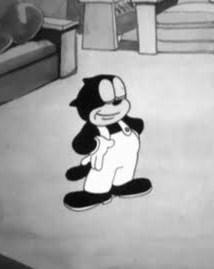
Beans the Cat is an animated cartoon character in the Warner Bros. Cartoons series of cartoons from 1935–1936. Beans was the third Warner Bros cartoon character star after Bosko and Buddy. He was voiced by Billy Bletcher. He was created by director Friz Freleng. The character was featured in nine cartoons made in 1935 and 1936.

Elmer's Candid Camera is a 1940 Warner Bros. Merrie Melodies cartoon short directed by Chuck Jones. The short was released on March 2, 1940, and features Elmer Fudd and an early Bugs Bunny prototype.

Angel Puss is a 1944 Warner Bros. Looney Tunes cartoon directed by Chuck Jones. The short was released on June 3, 1944.
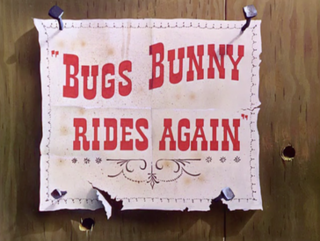
Bugs Bunny Rides Again is a 1948 Merrie Melodies animated short directed by Friz Freleng. The short was released on June 12, 1948, and stars Bugs Bunny and Yosemite Sam.

Bugs Bunny's Christmas Carol is an eight-minute animated film produced by Warner Bros. Television and DePatie–Freleng Enterprises, and aired on CBS on November 27, 1979 as the first segment of the Christmas special, Bugs Bunny's Looney Christmas Tales.

Transylvania 6-5000 (1963) is a Warner Bros. Merrie Melodies animated short directed by Chuck Jones. The short was released on November 30, 1963, and stars Bugs Bunny.

The Looney Looney Looney Bugs Bunny Movie is a 1981 American animated comedy package film with a compilation of classic Looney Tunes/Merrie Melodies Warner Bros. cartoon shorts and animated bridging sequences produced and directed by Friz Freleng, hosted by Bugs Bunny. The new footage was produced by Warner Bros. Animation. It was the first Looney Tunes/Merrie Melodies film with a compilation of classic cartoon comedy shorts produced by Warner Bros. Animation.

Show Biz Bugs is a 1957 Warner Bros. Looney Tunes animated short directed by Friz Freleng and featuring Mel Blanc. The short was released on November 2, 1957, and stars Bugs Bunny and Daffy Duck.
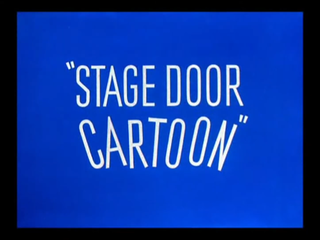
Stage Door Cartoon is a 1944 Merrie Melodies cartoon directed by Friz Freleng. The short was released on December 30, 1944, and features Bugs Bunny and Elmer Fudd.
Robert Cameron Bruce Jr. was an American voice actor and the son of Robert Cameron Bruce (1887–1948) who was a cinematographer and documentary producer. He was the narrator for a number of Warner Bros. cartoons in the 1930s and 1940s. The Looney Tunes and Merrie Melodies series' had occasional entries which were driven not by one of their stable of stars such as Bugs Bunny or Daffy Duck, but by individual short sketches, usually filled with sight gags and word-play. Later he was a writer and producer of industrial motion pictures based in Minnesota.
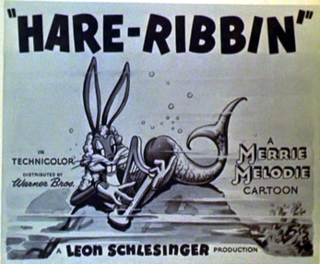
Hare Ribbin' is a 1944 animated short film in the Merrie Melodies series, directed by Robert Clampett and featuring Bugs Bunny. The plot features Bugs' conflict with a red-haired hound dog, whom the rabbit sets out to evade and make a fool of using one-liners, reverse psychology, disguises and other tricks. It was released in theaters by Warner Bros. on June 24, 1944. The title is a pun on "hair ribbon".
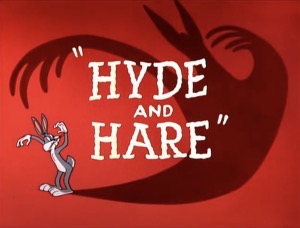
Hyde and Hare is a 1955 Warner Bros. Looney Tunes cartoon, directed by Friz Freleng. The short was released on August 27, 1955, and stars Bugs Bunny. The short is based on Robert Louis Stevenson's 1886 novella Strange Case of Dr Jekyll and Mr Hyde. The cartoon pits Bugs against Dr. Jekyll, who continues to turn into Mr. Hyde. The title is a play on the expression "neither hide nor hair."

Person to Bunny is a 1960 Merrie Melodies animated cartoon directed by Friz Freleng. The short was released on April 1, 1960, and stars Bugs Bunny, Daffy Duck and Elmer Fudd. It is the last cartoon to feature Arthur Q. Bryan as the voice of Elmer, and was released shortly after Bryan's death.
This is a listing of all the animated shorts released by Warner Bros. under the Looney Tunes and Merrie Melodies banners between 1940 and 1949.
